Nineteenth Century
The Influence of Sewing Machines on the Health and Morality of Workwomen
Nineteenth-century doctors worried that because sewing machines "produced such an excessive excitement of the sexual organs" they might have an immoral effect upon working women. Text from The Boston Medical and Surgical Journal (Aug 23, 1866):A young woman, whom he had known as the very picture of vigorous health, presented herself at his office in such a condition of emaciation, and with such a change of countenance, that he was greatly shocked at her appearance. The explanation which she gave was as follows.
For seven months, from morning till night, she had worked at a sewing machine, known as the "American machine." The constant motion of the lower extremities in propelling it had produced such an excessive excitement of the sexual organs that she was often compelled to suspend her work; and to the frequency of this effect and the fatigue resulting from it, she attributed the leucorrhoea and attendant loss of flesh and strength from which she was suffering.
The effect seemed to be naturally enough explained by the cause alleged, especially as in some of the machines at which she had worked the pedals were depressed alternately with one food and the other. This case, so serious in its nature, was regarded by M. Guibout as probably the result of a peculiar susceptibility on the part of the patient, and so very exceptional at the time as only worthy of record as a curiosity. But during the past year, he goes on to say, he found in the hospital Saint-Louis, three similar cases; and during the present year he had already found five in the same hospital.
He also adds that within a month "two females, entirely unknown to each other, and working in different shops, called upon him on the same day, to consult him for similar symptoms. The first of these, a blonde, in the most vigorous health when she began to work at the machine, in seven or eight months has become enfeebled, her embonpoint was gone, her general health had declined, and she had become the subject of a profuse leucorrhoea, which was daily increasing.
She said also that many of the girls in the same establishment were affected in the same way, by the same cause, "the continual movement of the lower limbs, the jar and the swaying of the body." She denied, however, that she had been troubled by the special symptoms mentioned by the first patient, but said that many of her companions had been. Many of them had been so annoyed as to be obliged frequently to suspend their work and leave the shop for the purpose of bathing with cold water.
The second of these two patients was a brunette, of entirely different temperament from the other. She had been obliged to give up her place after working at the machine for a year, on account of the same symptoms. To the inquiry as to any local excitement produced by it, she answered in the affirmative. To translate her own words: "Among 500 women who worked with me, there were at least 200 who, to my knowledge, suffered as I did; so that the operatives were constantly changing, none of them being able to stay long. It is a constant going and coming of women, who enter strong and well, and who go out weak and emaciated."
M. Guibout went on to recite other instances equally serious, but it is not necessary to quote them. The subject is one of very grave moment and worthy of the consideration of every physician. In the discussion which followed the reading of his paper, some of the members of the Society were disposed to question the frequency of the peculiar symptoms which he reported. He, however, maintained his position, urging that it was very difficult to get a confession from many of the victims of the machine, so that when directly interrogated, a negative response should not always be received as the truth. The large number of cases which had come under his own observation had led him to lay this painful subject before the Society.
I asked Microsoft's AI image creator to produce an image based on the article's title, and this is what it came up with:

Posted By: Alex - Wed May 17, 2023 -
Comments (6)
Category: Health, Medicine, Nineteenth Century
Lovely woman wants Sapolio
I've spent too long trying to make sense of the cryptic verbiage from this nineteenth-century soap ad.The first line must be a reference to Oliver Goldsmith's poem "When lovely woman stoops to folly."
Next, the ad writers evidently tried to come up with something that would rhyme with 'Sapolio,' but what did they mean by "what she wants must go"?
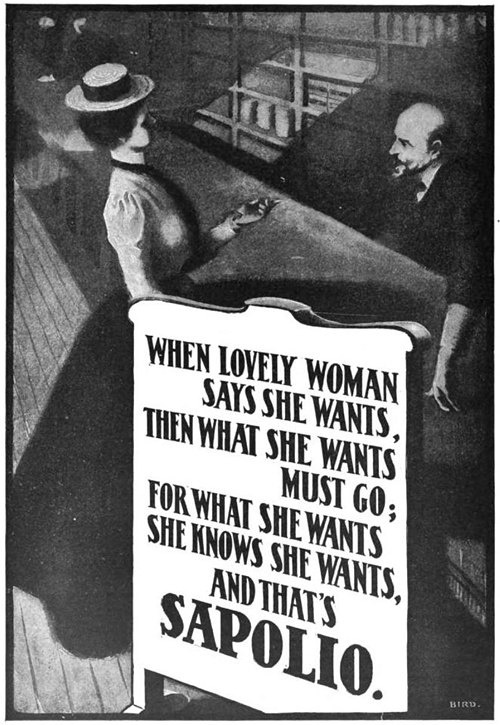
Posted By: Alex - Sat May 13, 2023 -
Comments (6)
Category: Advertising, Nineteenth Century
The Queen of Love and Beauty at the Veiled Prophet’s Ball
The Veiled Prophet Parade and Ball was a yearly civic celebration in St. Louis, Missouri, over which a mythical figure called the Veiled Prophet presided. The first events were in 1878. The parade and ball were organized and funded by the Veiled Prophet Organization, an all-male, secret society[3][4][5] founded in 1878 by prominent St. Louisans.
The organization chooses one member to be a Veiled Prophet who conducts meetings and oversees activities but not necessarily for one year, spokesman Allyn Glaub said in 1991. They were a highly select group culled from the area's business, civic and governmental leaders, "the people who run St. Louis and St. Louis County."
See the 1938 Veiled Prophet below.
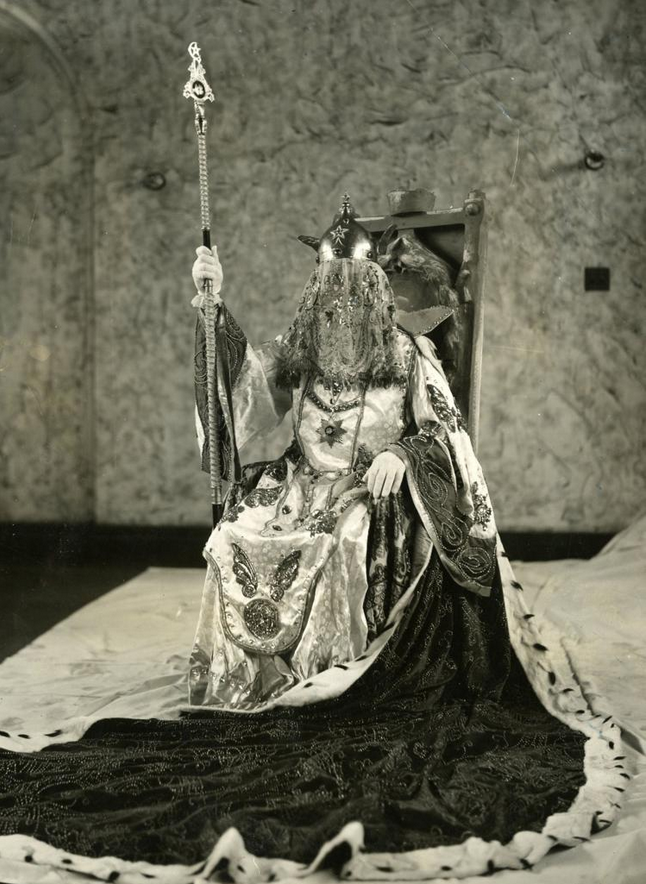
The Wikipedia article on the ball itself here.
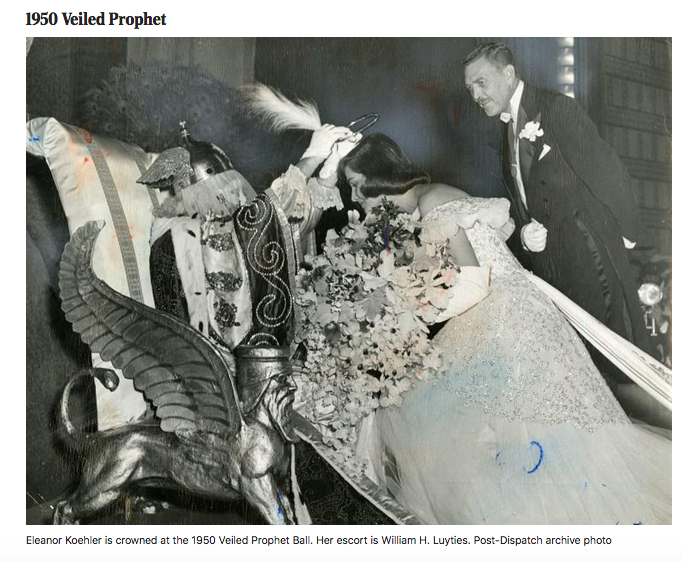
A list of all queens.
Posted By: Paul - Mon May 08, 2023 -
Comments (0)
Category: Awards, Prizes, Competitions and Contests, Beauty, Ugliness and Other Aesthetic Issues, Clubs, Fraternities and Other Self-selecting Organizations, Disguises, Impersonations, Mimics and Forgeries, Parades and Festivals, Regionalism, Nineteenth Century, Twentieth Century, Twenty-first Century
Loma, A Citizen of Venus
Read it here."Long narrative on a cosmic germ theory of evolution. A Venusian comes to earth to educate the male fetus of an unwed mother so that the fetus will become the apostle of Venus's ideal culture. On Venus clothes are considered ugly and unsanitary, all human faculties are developed and 'balanced,' and social status is determined by a network of interpersonal relations among strangers, acquaintances, associates, brothers, sisters, lovers, and consorts -- the more of the latter three, the higher the status."
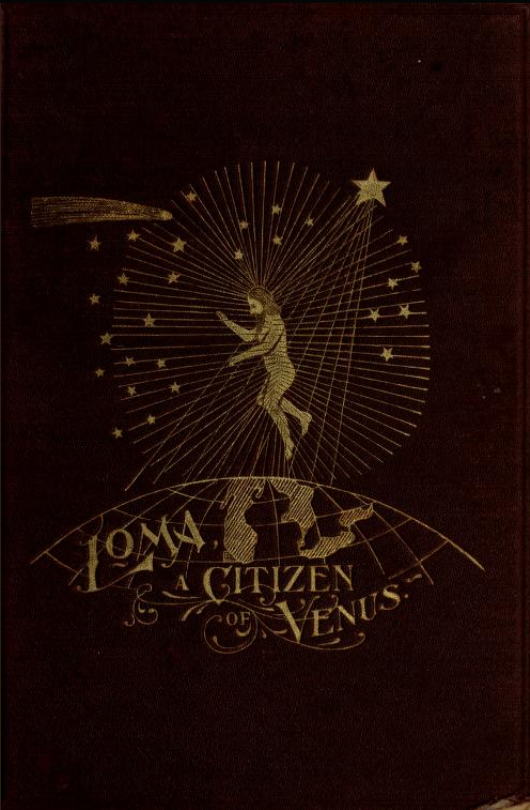
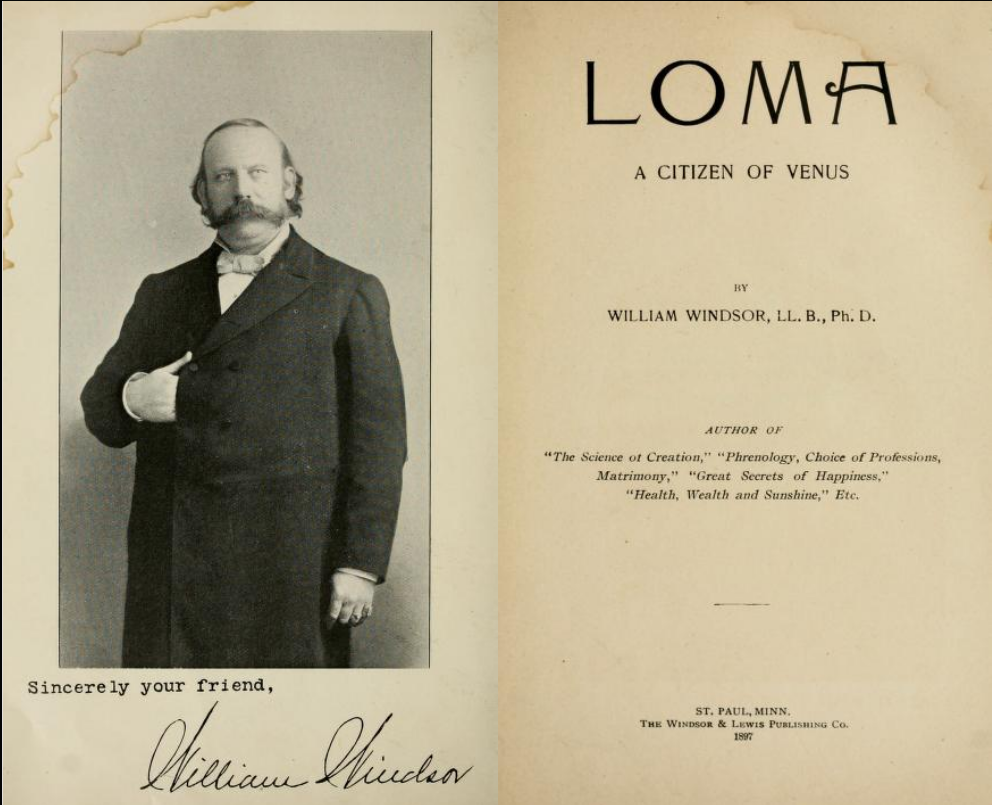
Posted By: Paul - Sun Apr 23, 2023 -
Comments (5)
Category: Eccentrics, Gonzo, Demento, Kooky, Wacky and Out-there, Science Fiction, Nineteenth Century, Pregnancy
A third leg
Back in the nineteenth century, Alexander Robinson operated a photographic studio on the Isle of Man. In 1885 he applied for a British patent (British Patent Specification 15,376) for an unusual invention — a fake third leg, which he envisioned using as a prop in his studio.
From his patent application:
His invention makes more sense once you know that the Isle of Man's heraldic coat of arms consists of three legs. I imagine that tourists would come to his studio to get a photograph of themselves with three legs, just like the Isle of Man.

I don't know if Robinson was ever granted a patent for this. The British patent office, unlike the American one, is not fully searchable online. More info: History of Photography journal
Posted By: Alex - Tue Mar 14, 2023 -
Comments (3)
Category: Photography and Photographers, Patents, Nineteenth Century
Virtue Board Games
I never knew that "Snakes and Ladders" belonged to this category.Read an excellent short history here.
One example, with description taken from this other site:
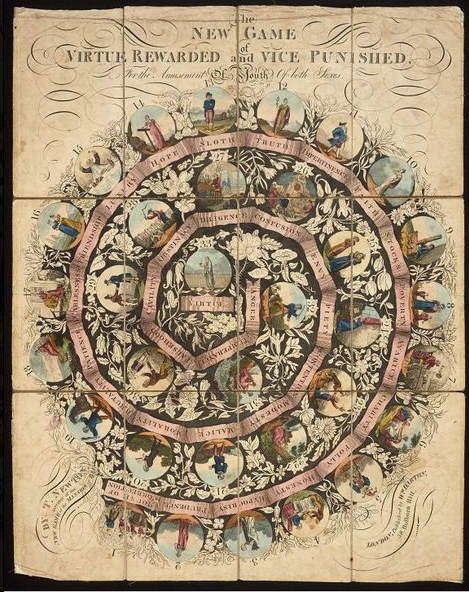
A frankly insane 19th century board game.
The game comes on a series of hand painted paper tiles attached to a thin cloth allowing it to be folded up and put into a drawstring case. When unfolded, it forms a spiral-shaped track on the board going from the outside and running anti-clockwise to the centre. Included are some things to use as counters and a spinner, through which a matchstick can be pushed to form a single-dimensional-rotary d4 equivalent. This is intentional by the makers as they did not want to be seen to be encouraging customers to bring a dice box into private homes. Yes, that is the stated reason as given in the rules to this game, which is described as "for the Amusement of Youth of both Sexes."
Also included are a number of tokens which are handed out to players as they play. Players start at the beginning (i.e. before space 1), roll the dice spin the spinner, which yields a value from 1 to 4 (were d4s available in 1818?), and move that number of spaces. Each space is named with either a Virtue or a Vice and every single one has an effect, usually relating to the rewards that such a virtue might bring (i.e. receiving tokens), or the comeuppance of "the dangerous paths of Vice" which do bad things to the player. Apart from "Hope" which requires the player to "wait with patience until the next turn."
So the players spin, move, and things happen to them, much like the Game of the Goose. It's quite clear from reading the rules, however, that the moral behind the game is highly flawed. Many of the Virtue spaces reward you with "tokens" yet these tokens have zero bearing on the outcome of the game. It is mentioned that the first player to land on the final space (with the whole if you overshoot you must count back rule in effect) "claims the contents of the bank and wins the game" yet there is no indication of what the tokens are for. The first player to the final space, imaginatively named "Virtue," wins regardless of how many tokens everyone has. This means that you could have systematically landed on every vice space imaginable but if you're first to land on the final space exactly, you win regardless of the number of tokens in the bank. The rules also don't specify how many tokens should go in the bank and with the preponderance of "vice" spaces that send you back often a long way, i.e. to "House of Correction" (space 1) or "Stocks" (space 9) a player skilled in fudging spinner spins could well find themselves with an infinite number of tokens. So even if you insert the house rule that the player with the most tokens wins, the player getting to the end "claims the contents of the bank" and therefore has infinity tokens and wins that way.
So what's the real moral message imparted by this game? That stopping to help and be charitable and nice is all well and good but the victory in life goes to whoever barges through the fastest or to the luckiest player. The attempt at inculcating a set of moral values into the youth of both sexes is undermined by the fact that players don't have to make any active choice; at the end of the day, whoever spins the lucky numbers gets the prize at the end of the day.
I can't help but feel that this kid of explains something about Victorian morality though I can't think what.
Posted By: Paul - Fri Feb 10, 2023 -
Comments (0)
Category: Games, Nineteenth Century, Twentieth Century, Ethics and Morals
Rollerskate Polo
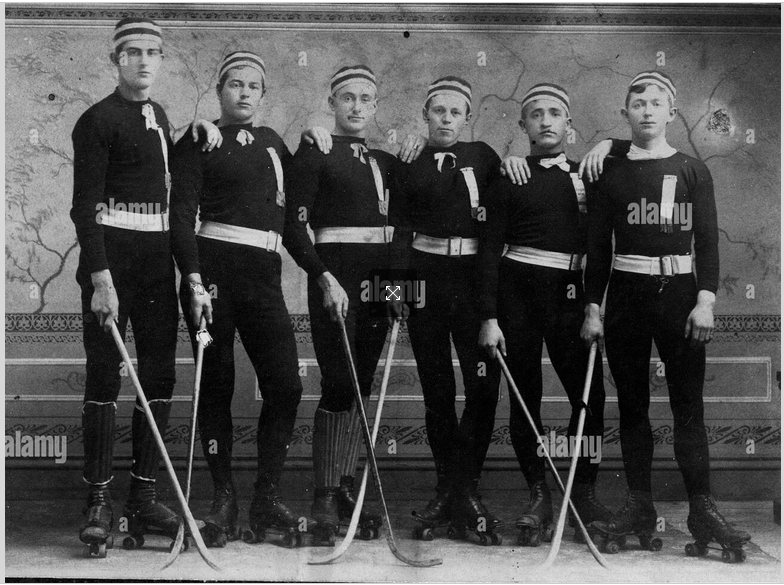
This is a Roller Polo team in the 1890s. Roller skating was big in 1870s USA, and when polo was brought in by James Gordon Bennett in 1876, the two sports quickly blended. Roller polo was played with a ball. Roller rinks were converted to 40 by 80-foot courts with a chicken-wire goal cage at each end. The one-handed sticks were 1 inch in diameter and they played 3 15-minute periods. Players wore team uniforms and goalies wore more pads. Everybody wore Roller Skates.The man at right has a skate key hanging from his belt.
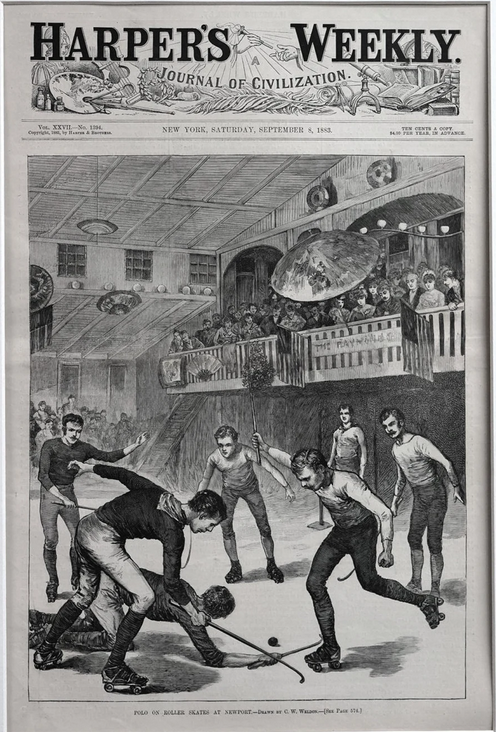
Posted By: Paul - Fri Feb 03, 2023 -
Comments (2)
Category: Sports, Nineteenth Century
Combined Suspenders and Garters
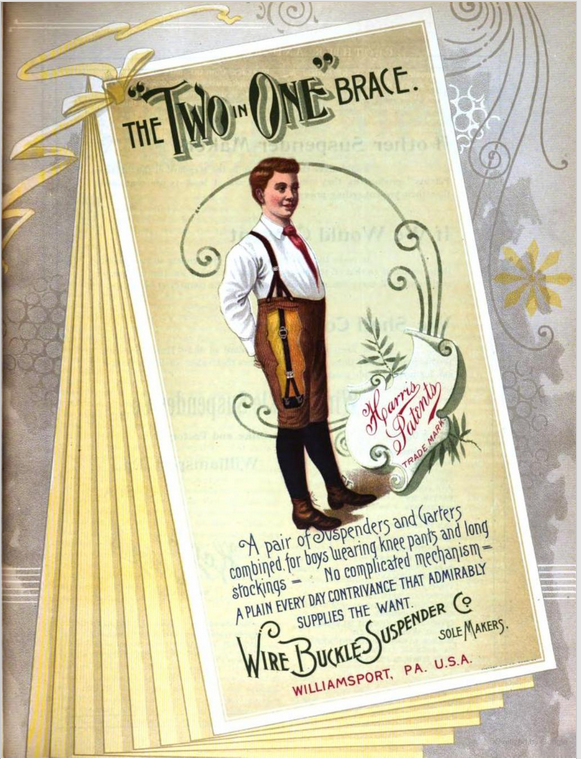
Source.
Posted By: Paul - Mon Jan 30, 2023 -
Comments (3)
Category: Fashion, Inventions, Nineteenth Century
Artwork Khrushchev Probably Would Not Have Liked 48
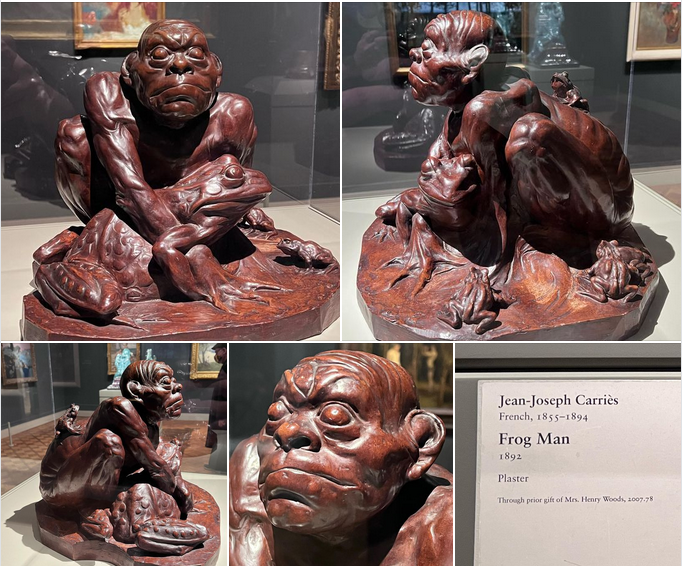
His Wikipedia page.
Posted By: Paul - Thu Jan 26, 2023 -
Comments (0)
Category: Animals, Art, Cryptozoology, Nineteenth Century
Cologne Drunkards
In the late nineteenth century, a brief moral panic emerged about the alleged existence of "cologne drunkards" — society women who inebriated themselves by means of sugar cubes soaked in cologne.Seems like an expensive way to consume alcohol, but I guess it's plausible that some women really did this.

Good Health magazine - Apr 1885

Philadelphia Times - Feb 7, 1893
Posted By: Alex - Mon Jan 23, 2023 -
Comments (1)
Category: Inebriation and Intoxicants, Nineteenth Century, Perfume and Cologne and Other Scents

| Who We Are |
|---|
| Alex Boese Alex is the creator and curator of the Museum of Hoaxes. He's also the author of various weird, non-fiction, science-themed books such as Elephants on Acid and Psychedelic Apes. Paul Di Filippo Paul has been paid to put weird ideas into fictional form for over thirty years, in his career as a noted science fiction writer. He has recently begun blogging on many curious topics with three fellow writers at The Inferior 4+1. Contact Us |




